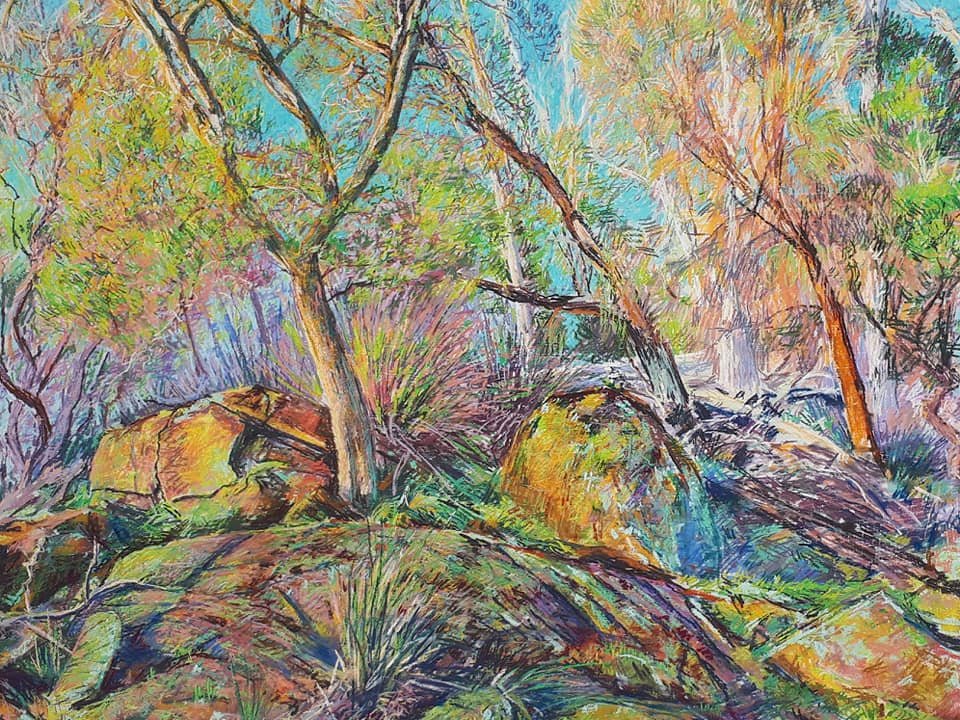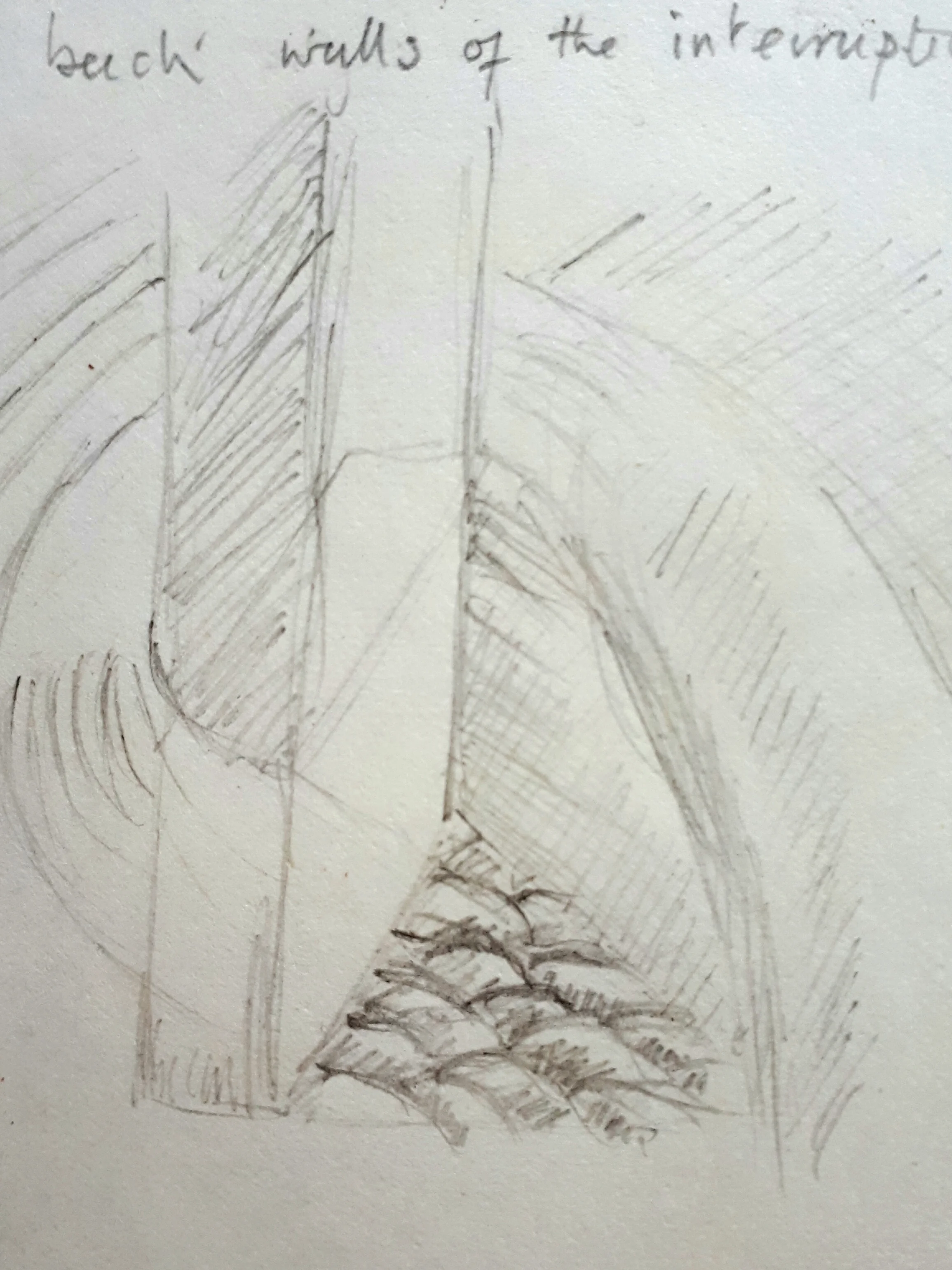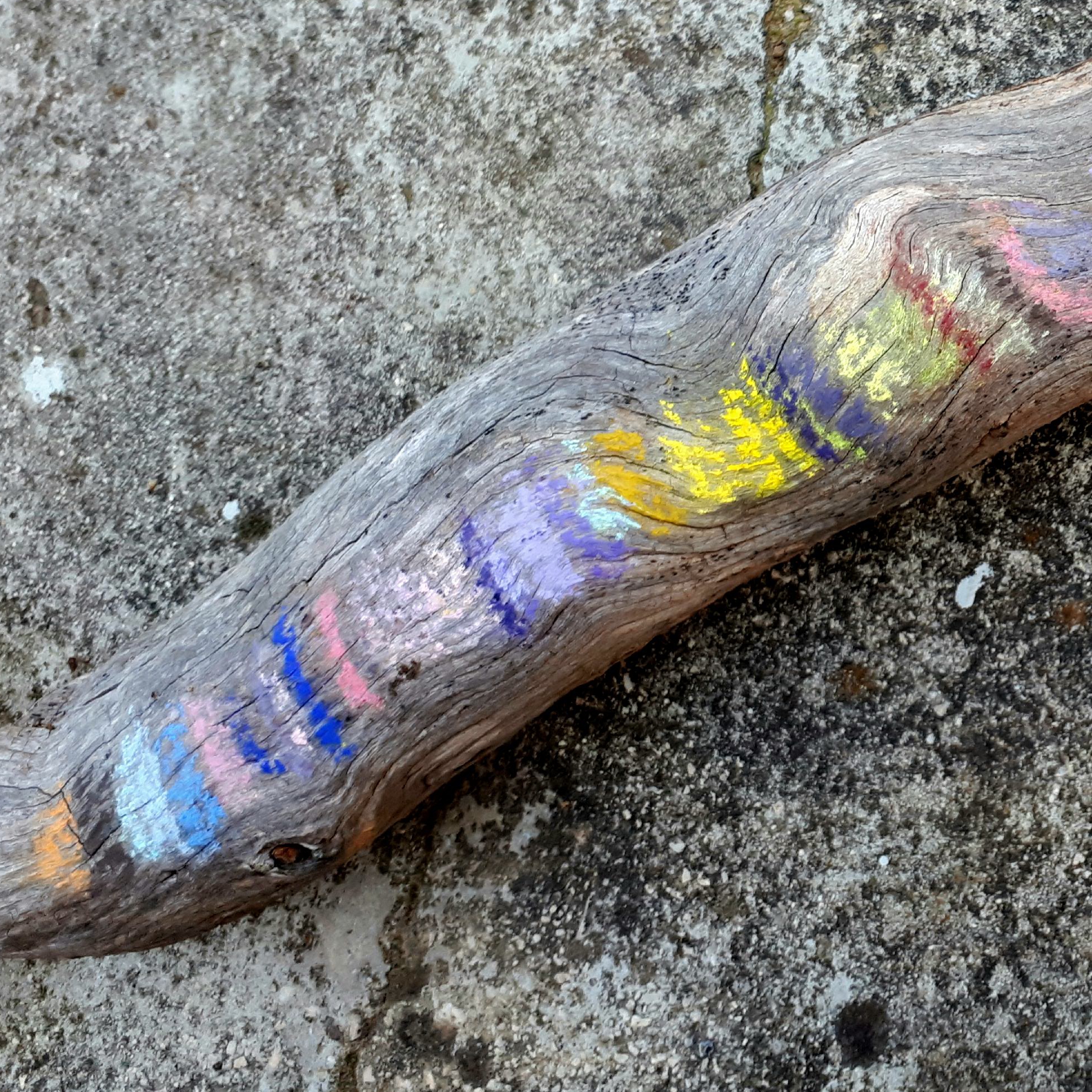The 'Birth Curtain' began with a request to me by the Launceston Birth Centre in 1984. Could I design a background for the newly established birthing centre which would provide a peaceful environment for the mothers-soon-to-be... Something Natural, which would take their minds away from labour and medical interventions.
"Which aspects of nature do women in labour prefer to think about? " I asked and I was told.. "Water, Birds, and trees".
Yes I replied, I'd love to do that, but could we include figures?
Figures? Yes, I replied. Birthing doesn't just happen Could we show the stages of pregnancy and labour too? Could we make the curtain both a celebration of motherhood and a teaching aid? Could we look at pre- Christian art, a time before there was shame and guilt about the body's natural functions including pregnancy and birth?
There was a pause here while the committee discussed whether such images might be too "Confronting". Nothing like as Confronting as Birth itself said I, who had been much moved by my own experience assisting in the birth of my own children.
We should celebrate the wonder of this moment in form and colour and do so with the truth of a medical textbook.
The committee needed to think this over snd came back the next day in unanimous agreement. Could they help with design or printing? Of course they could.
Next day I begged some large rolls of blank newsprint paper from the local newspaper, taped them to the long internal corridor of the large old house we lived in, and started drawing; trees, water, birds, but where to begin the figures? And how many?
It seemed natural to start with that private and mysterious moment, known only to her, when the mother first feels her child kick in the womb. At this stage she is still moving freely, even running.
Among aboriginal peoples this moment is sacred; the mother must remember the place which is now a spirit gift to her child, a totem the child must look after for their lifetime.
First of three panels of the completed Birth Curtain, 1985.
STATIONS 0F A BIRTH
Printed from cut paper stencil and screen printed onto unbleached cotton duck. This was the first of the seven ‘Stations of a Birth’ not that this and the following figure groups owe anything to the Christian story except In that each of the figure groups in the birth curtain are an attempt to freeze a particular moment in time.
1. FIRST KICK
The woman is young and wholly absorbed in the sensations of wonder which accompany pregnancy, especially at this particular moment, around 4 months after conception, which nothing has prepared her for, when the foetus gives its first kick and she becomes fully aware that she is carrying another life.
The foetus is shown in the X-ray style favoured by traditional Australian Aboriginal painters, a useful shorthand which shows the placement of the internal organs in relief.
As she runs the mother is aware of a protective circle of life around her which follows her as she runs; sometimes it feels like a fluttering, as of birds wings & ‘Of a girl, mad as birds’ (Dylan Thomas), sometimes it is the imprint of her feet on the ground, sometimes it is the movement of wind in her hair which could also be water, or leaves.
This is also the moment of Spirit conception, sacred in Australian Aboriginal culture when the Spirit of the place enters the embryo through the foot of the mother, and she must take notice of thatplace which becomes the unborn child’s Totem, and as the child grows up they must honour and protect that place.
I used cut paper stencils to delineate the figures in this project because the clean margin produced by a sharp razor shows the outlines of the actors in the drama unambiguously and gives a sculptural and rhythmical feel to the figures. Also because cut paper, cheap as it is, can give a very accurate clear edge to screen printing.
2. EXPLANATION
The role of explanation often falls to the mother.
The simplest explanation is also the best; this was adapted from a photo of the mother of our daughter, then a year and half, asked where is the baby?
She simply lifted her dress and pointing to her belly, explained what was happening and would happen.
I included this little tableau in the curtain because it seemed the perfect explanation.
Also because the role of explanation is an important part of the process of pregnancy. It is rehearsal for what is to come. The mother needs to prepare her family and all those around her, (herself included) for the momentous changes that lie ahead for all of them.
'Explanation' in the sense of a rehearsal of what is to come has not featured much in European art since a time before the Renaissance when storytelling played a vital role in Art. Giotto was perhaps the last painter who painted entire visual sequences, usually connected with the life and passion of Christ on the walls of the churches in his hometown of Orvieto.
These scenes were of course re enacted as plays in every town and little village in Europe. Everyone knew them and took part in them and the churches and cathedrals were giant concert halls, carved on the outside and painted on the inside, dedicated to telling the Christian story.
The Birth Curtain does not tell a religious story, but the method of storytelling owes much to the art and aesthetic of that era when art was for Everyman.
Stations of a Birth was a small and humble attempt to present a universal story in a language which could be read by people of all ages including young children.
The sequence of 'drawn sculptures' which follow the one above are taken from many sources, times and places and are presented to celebrate and explain the mysterious natural pathways we must all follow before we can take our first breath and make our first angry cries on earth.
3. LABOUR
It's not for nothing that the process of giving birth is called Labour.
Certainly it is a labour for the mother but it is an ordeal for the baby too. There are times during labour when the contractions the mother's uterus is undergoing in order to move the foetus and its placenta along the Birth Canal suppress the baby's heart rate from a cheerful sounding150 beats per minute down to a tenth of that, or less. For the parents listening to the foetal heartbeat on a monitor the heart which sounded like a pony galloping down a dry pathway slows to a canter and then to a walk, and then almost stops.. The parent's hearts stop too of course, until the little heart begins to beat again and is soon galloping down its own private pathway towards the day.
The process for both parents is unlike any other. It is a spiritual journey etched into their memories for life; through joy to terror, terror to pain, pain to tedium, tedium through to the bliss and relief of the Birth.
Roles, and stereotypes are largely cancelled, and though the presence of male partners is often welcomed, they mostly find that their 'Malehood' is best surrendered at the door. They are there to help in this unfamiliar archetypal female world into which they have pitched themselves, one they cannot imagine until they have experienced it, after which it is seared into their memory forever.
4. THE CROWNING
The moment when the baby’s head appears in the vagina is indeed the crowning point of labour, with birth usually imminent.
The position shown is not necessarily the most comfortable for the mother but is commonly adopted because it allows the midwives to safely catch the baby as it emerges.
It also allows the obstetrician easy access to free the head if forceps are necessary to free the head or the umbilical cord has become tangled around the baby’s neck, as does occasionally happen.
Once the head is out the baby draws its first breath and usually gives a loud, angry yell, which gives cause for relief and celebration among the midwives and much delight to the exhausted mother and her partner.
The rest of the baby’s body follows very quickly and the midwives remove the remnants of the placenta, or caul from the body and rapidly clear the airways so the child can breathe unobstructed.
At this moment the skin of the baby is often bluish, but as it continues to yell and oxygenate its lungs, a patch of pink appears over the heart and spreads rapidly outwards to cover the whole body.
All moments of a birth are wonderful but the moments before and after the crowning happen so fast that they are the most surprising, unpredictable, and magical of all.
5. FIRST TOUCH
An especially tender moment when the midwife lays the baby on the mother’s breast with the umbilical cord still attached. This is the first time the mother has been able to touch the baby and the baby to feel the mother’s hands.
Still exhausted from the long labour, the mother feels an overwhelming relief that her child is safe, and who knows what the baby is feeling at this moment? Relief too very likely, and though not expressible in words at this stage in their life, some people are able later on, and through intense meditation, to remember their sensations before and after their birth with great clarity. (Panel 7).
When I drew these groups of figures I wanted to express their emotions through their physical presence and their interactions with those around them.
Being suddenly and completely dependent on others is an unusual situation for those born in the twentieth century and beyond but the stages of birthing and motherhood have not changed much since mankind lived in caves during the last ice age, and before.
I wanted to show something that is as true today as it would have been fifty thousand years ago.
Something an explorer might find drawn on the wall of a cave, and still might, one day. Who knows?
6. MOTHER AND CHILD ALONE TOGETHER
7. THE FAMILY CIRCLE
Although the figures in this story were cut into paper and printed onto canvas I thought of them in relief, as groups of 3 dimensional figures, something like the ceramic sculptures by Piero Della Robbia, or the relief carvings in marble favoured by Renaissance sculptors; or even the Greco-Roman friezes where figures are carved in the act of dancing, feasting, or fighting.
By presenting only the outline of the figures I wanted to give each group a monumental aspect as if they were back lit; simplified sculptures painted in colour as sculptures used to be before the Renaissance came along.
Each group of figures then became an event on their own, one act in a story divided into seven Acts, or Stations, of which this is the sixth, where the mother, exhausted but fulfilled, allows her family to crowd around the cradle to catch a glimpse of the sleeping child.
There is an observation by the Plains Indians, ( among other cultures) that the connection between mother and child does not end at birth but continues for as long as the mother is breastfeeding, in the form of a shared illumination which can be perceived as a blue light, emanating from the mother’s womb, but also returned by the child.
This blue light envelops and nurtures them both and the child is aware of it. But it is also fragile and an act of violence or anger by a parent anyone close to the child can extinguish that light, and with it, the child’s spiritual well-being, sometimes for life.
The perception of the blue light; as an awareness shared between mother and child is central to this panel. It is what marks the mother out as unique and irreplaceable to the child quite as much as the child becoming irreplaceable for the mother.






























